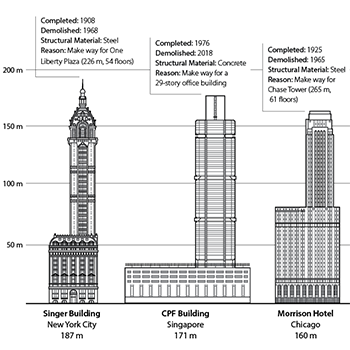Filter by
You must be a CTBUH Member to view this resource.
Singer Building
Building
Demolished
10013
office
steel
186.6 m / 612 ft
41
1
15
3 m/s
Proposed
Construction Start
Completed
Demolished
Material Supplier refers to organizations which supplied significant systems/materials for a building project (e.g. elevator suppliers, facade suppliers, etc).
You must be a CTBUH Member to view this resource.
Usually involved in the front end design, with a "typical" condition being that of a leadership role through either Schematic Design or Design Development, and then a monitoring role through the CD and CA phases.
Material Supplier refers to organizations which supplied significant systems/materials for a building project (e.g. elevator suppliers, facade suppliers, etc).
Building Tall Lecture Addresses Skyscraper Renovations
29 November 2018 - Event
CTBUH Study Examines Tallest Demolished Buildings
4 June 2018 - CTBUH Research

27 April 2018
World's Tallest Demolished Buildings
CTBUH Research
Although the world has more than 1,300 buildings of 200 meters or higher, no tall building of more than 187 meters has been demolished, with...

27 April 2018
World's Tallest Demolished Buildings
Although the world has more than 1,300 buildings of 200 meters or higher, no tall building of more than 187 meters has been demolished, with...

01 August 2011
New York’s dramatic skyline, over a century in the making, has for years been the envy of cities around the world. From the very birth...

12 June 2008
The Tallest Buildings in the World: Past, Present & Future
Over time, the average height of the 100 tallest buildings in the world has been steadily increasing. However, by 2010, this average height will have...
29 November 2018
The latest event in the Building Tall Lecture Series, hosted by the Chicago Architecture Center and CTBUH, featured a panel on revitalizing iconic skyscrapers.
4 June 2018
Following the planned demolition of 270 Park Avenue, the Council has conducted a research study on the Top 10 Tallest Buildings Demolished so far.
5 November 2014
The first meeting of the CTBUH Tall Buildings Demolition Working Group discussed an entire spectrum of possibilities for demolition.
4 October 2011
New York’s dramatic skyline, over a century in the making, has for years been the envy of cities around the world. From the very birth of the tall building typology, New York has been at the forefront of the scene.
Subscribe below to receive periodic updates from CTBUH on the latest Tall Building and Urban news and CTBUH initiatives, including our monthly newsletter. Fields with a red asterisk (*) next to them are required.
View our privacy policy